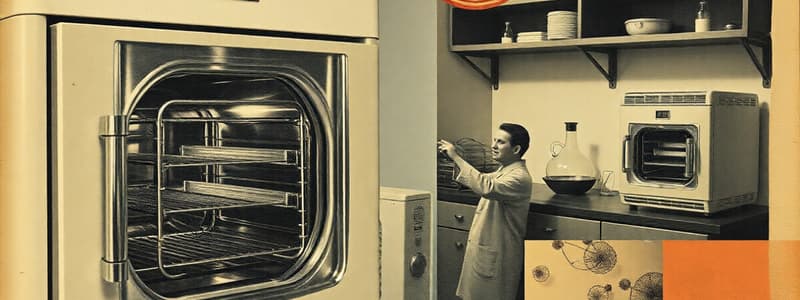Podcast
Questions and Answers
Which of the following is NOT a disadvantage of using a hot air oven for sterilization?
Which of the following is NOT a disadvantage of using a hot air oven for sterilization?
What is the primary mechanism by which a hot air oven controls humidity levels during sterilization?
What is the primary mechanism by which a hot air oven controls humidity levels during sterilization?
Which of the following is NOT a common hazard associated with using a hot air oven?
Which of the following is NOT a common hazard associated with using a hot air oven?
What is the most common method of sterilization using a hot air oven?
What is the most common method of sterilization using a hot air oven?
Signup and view all the answers
Which of the following accurately describes the principle behind hot air oven sterilization?
Which of the following accurately describes the principle behind hot air oven sterilization?
Signup and view all the answers
Flashcards
Hot Air Oven
Hot Air Oven
A lab instrument that uses hot air for sterilization at a uniform temperature.
Sterilization
Sterilization
The process of killing all microorganisms on an object or surface.
Advantages of Hot Air Ovens
Advantages of Hot Air Ovens
They effectively sterilize various devices under controlled humidity and temperature.
Disadvantages of Hot Air Ovens
Disadvantages of Hot Air Ovens
Signup and view all the flashcards
Risk of Ovens
Risk of Ovens
Signup and view all the flashcards
Study Notes
Oven Use in Microbiology
- A hot air oven is a laboratory instrument used to heat products to a uniform temperature.
- It's used to sterilize products within a specific time frame under controlled environmental conditions (humidity, pressure).
Oven Sterilization
- Hot air sterilization using an oven is a common sterilization method.
- Temperatures can be elevated to high levels, allowing for the safe sterilization of a wide variety of devices and instruments.
Oven Parts
- Heater: Provides the heat.
- Thermostat: Controls the temperature.
- Temperature Indicator: Shows current temperature.
- Timer: Controls sterilization duration.
- Coat/Cabinet: Encloses the chamber.
- Fibreglass: Provides insulation.
- Chamber: The interior area where items are sterilized.
- Shelves (Mesh): Platforms for holding items.
- Motorized fans: Circulate air within the chamber.
- Control Panel: Allows for monitoring and adjustments.
- Fuse: Protects the oven from overcurrent.
- Door: Allows access to the chamber.
- Power Supply: Supplies electricity to the oven.
Oven Hazards
- Ovens generate high temperatures and open flames, posing a burn risk.
- Accidental contact with these components can lead to injuries.
Oven Principle
- Electrical energy is converted into heat energy via a heating coil.
- Air circulates within the chamber due to convection.
- Items are sterilized by conduction, where heat moves from the outside to the inside.
- The thermostat regulates the temperature.
Hot Air Oven Disadvantages
- Compared to other sterilization methods (like autoclaves), hot air ovens have lower heat capacity.
Hot Air Oven Advantages
- Used to sterilize products within a specific time period under controlled humidity, pressure, and other environmental factors.
- Controls humidity levels by removing moisture from products, combining airflow with heat.
Hot Air Oven Applications
- Sterilizing glassware, metal instruments, and certain pharmaceutical products like oils and waxes.
- Less suitable for items sensitive to heat like plastic wares, fabrics or rubber.
Oven Sterilization Methods
- Not suitable for all types of materials, such as plastic wares and heat-sensitive materials.
- Sterilization may be achieved in various ways including moist heat, dry heat, radiation, ethylene oxide (EtO) gas, vaporized hydrogen peroxide, and chlorine dioxide gas or vapor.
Disinfection
- Disinfection aims to minimize harmful microbes to a negligible level.
- Only vegetative cells are killed; not spores.
- Chemical methods (like phenol, alcohol, chlorine, and iodine) are common.
- Examples include everyday use like pasteurization and disinfecting urinals.
Comparisons Dry vs Steam Sterilization
- Dry Heat relies on oxidation and dehydration.
- Higher operating temperatures (320°F-356°F/160-180°C).
- Longer sterilization times.
- Suitable for various materials like glassware, metal instruments, certain pharmaceutical products.
- Steam Sterilization relies on moist heat and steam penetration.
- Lower operating temperatures (250°F-273°F/121°C-134°C).
- Shorter sterilization times.
- Suitable for a broader range of materials like liquids, glassware, plastics, rubber, and textiles (but not always oils or certain heat-sensitive materials).
Studying That Suits You
Use AI to generate personalized quizzes and flashcards to suit your learning preferences.
Related Documents
Description
Explore the critical role of hot air ovens in microbiology for sterilization. This quiz covers the parts of an oven, sterilization techniques, and the principles behind effective heating. Understand how each component contributes to a controlled environment for sterilization.



